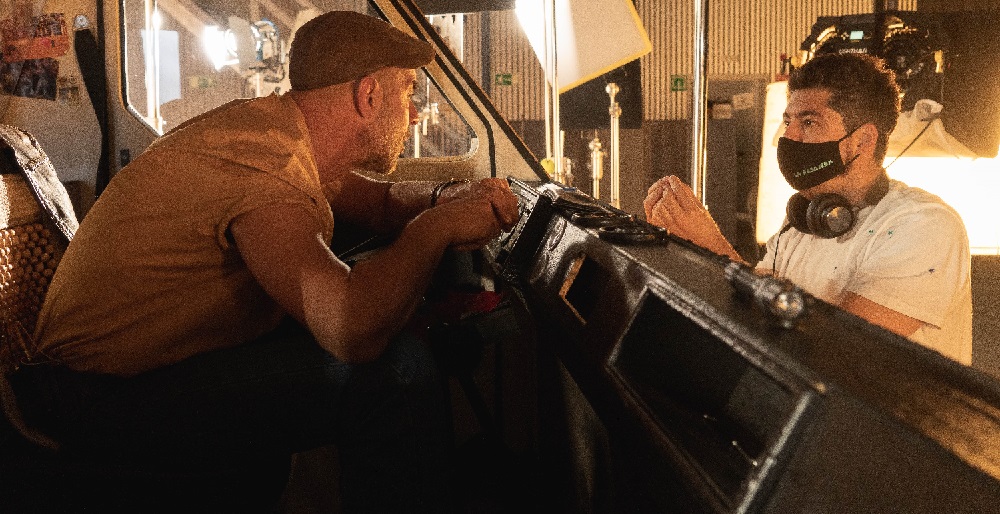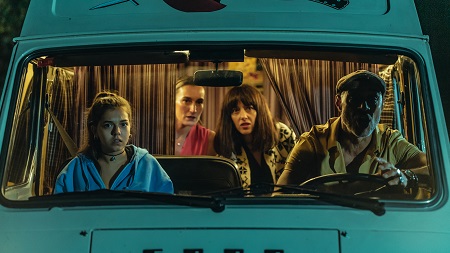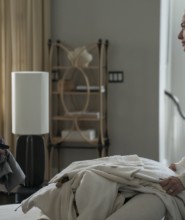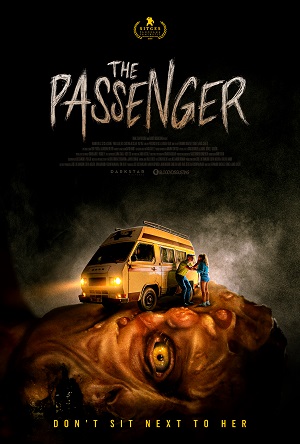
“The Passenger” – Interview with Fernando González Gómez
by Sara Michelle Fetters - June 10th, 2022 - Film Festivals Interviews
a SIFF 2022 interview
Director Fernando González Gómez Drives into Danger with The Passenger
One of my favorite discoveries from this past April Seattle International Film Festival was directors Fernando González Gómez and Raúl Cerezo’s horrifying black comedy The Passenger. It is a bleakly thrilling character study following Blasco (Ramiro Blas), the driver of a ride service van traveling across Spain with three female passengers, Mariela (Cecilia Suárez), Lidia (Cristina Alcázar), and Lidia’s daughter Marta (Paula Gallego).
Blasco is chauvinistic and something of a blowhard, seemingly unable to stop spouting all sorts of offensive gibberish, even if part of him knows the drive would go a bit smoother if he could keep his mouth shut. But things take an even more mysterious, and increasingly ominous turn when they pick up the injured new passenger, the race against time to save this stranger soon transforming into a fight for their own survival as the trip progresses.
The Passenger is a smart, character-driven shocker. But what begins as pitch-black commentary and incisive social commentary soon becomes something else entirely. The last third of the picture is a rollercoaster of gruesome, deeply unsettling suspense, everything building to a climax that had me sitting on pins and needles as I watched Blasco’s van finally reach its all-too-final destination.
I sat down with Gómez over Zoom to briefly chat about the making of The Passenger. Here are the edited transcripts of what he had to say:
Sara Michelle Fetters: This is a bit of a roller coaster ride that is going to really discombobulate some people. What was it that inspired you to tell this story?
Fernando González Gómez: My friend, now my brother, Raúl Cerezo, the co-director with me of The Passenger, he was driving a van to the Sitges Film Festival five or six years ago. He was using a very popular app in Spain called BlaBlaCar. It’s an app where you can share your trip with strangers in order to save money because of the gas or whatever. You say, we’re going to drive from Madrid to Barcelona, 9:00 AM tomorrow, Monday and these are the characteristics of the driver. You can say if you talk a lot or if you smoke or not, and all of these things are items Blasco mentions in the movie.
So Raúl was driving to Sitges and was with his friend and partner, Helion Ramalho, who is one of the producers of the film. They were traveling with an old woman, and everything was nice and, in a moment of the trip, they pick up another guy. In this case it was a black guy, and in the moment that he entered into the car the woman started to be a racist monster to him.
In that moment, Raúl and Helion realized that this situation could be a movie, and they transformed the idea of this old woman, this racist monster, into a real monster, and this is the starting of The Passenger.
SMF: It’s interesting, because your film brings up a lot of intriguing ideas relating to racism and misogyny along with so many other hot topics that are going on in the world right now. You look at them from such a complex but non-judgmental way. Was that difficult?
FGG: Yes. We have three modern and strong girls with this old man [who is] installed in the past with all of these problems and all of this passing in his life. It was difficult task.
We worked a lot with the tone. What tone could be the correct tone to be in between the comedy. But when the drama comes, we need to be able to understand the drama moments and feel the drama moments with the characters and understand every of them. We don’t want to judge Blasco. It’s a good idea that, step-by-step, they disappear but, with Blasco, we need to know that there are people like him.
SMF: The film forces the audience to decide for themselves who are the real monsters. Are there even monsters here? And, more importantly, what would they do if they were in a similar situation?
Did you feel like that there was a danger where you were almost challenging your audience too much?
FGG: It’s the kind of histories that we want to tell to the audience. We love that in our movies you can find a subtext. You can find more things when you watch a second time, as you said, you can probably see all the subtext and all of these problems in the in-between. We liked to do this. We liked that the audience knows very well the characters, that they are a part of this trip with them, know their past, and know their histories in order to suffer with them.
In the modern movies we see that you are like a voyeur in another building just watching something happening, and it doesn’t matter what is going to happen with the characters. It doesn’t matter what is going to happen because you don’t know anyone. You don’t know Marta. You don’t know Blasco. You don’t know their interior problems, their history. Why are they there? Why are they doing this trip together?
We do not want that. For us, it’s important to develop all the characters. We spend, I think it’s 20 minutes, with them. Learning about them. If we erase the first sequence of the movie and we start when they begin the trip you are in a daily comedy with normal characters traveling together. That’s all. That’s not this movie.
SMF: I love that you bring up the juxtaposition between the comedy and the drama, how it all slowly and insidiously grows more serious and more uncomfortable and more terrifying as events progress. Was that difficult to balance? How do you balance those comedic aspects, even if they are dark comedic aspects, with the full-throttle terror to come?
FGG: Yes. This was probably the hardest part. The characters were really well done in the script by Luis Sanchez-Polack. Everything was very, very defined, very specific. When we were working, Raúl and I, we were designing the characters to reflect the script. There was a lot of work on this text.
I think the moment when we knew the tone would work, it’s when we started to work with the cast, when we finally found our actors and we start working with Cecilia Suárez, Cristina Alcázar, Ramiro Blas, and Paula Gallego. That’s when we knew.
One important point is to know that Paula, who plays Marta, entered into the movie one week and a half to start of filming because we had a problem. We were working with another actress and we had a problem two weeks before the start. We had to start a crazy search for a new actress. Finally we found Paula, and she did a great job entering in this context. She stepped right in. We were really happy the chemistry between her and Ramiro Blas. This helped us find the correct tone.
SMF: For a motion picture that is, by and large, even though it’s on the road, even though that you have a lot of exteriors, is pretty much self-contained for the majority of the film. You’re inside the vehicle. Yet, this film showcases an incredible visual style. How did that work? How did you guys figure out visually to tell this story so that you could move from interiors to exteriors and make the vehicle itself another character in the film?
FGG: Yes. This is a good point. When we started working on the planification, Raúl and I, we had two musts. The first was that we always want to have a cinematographic language. Okay? When we put the camera in somewhere, we have a reason to do it. Okay? This is first point.
Second point, we don’t want to bore the audience, because we know when we read the script that there’s 80% of the movie inside the vehicle. We need to be fresh and also we need to keep our cinematographic language. We work a lot with Ignacio Aguilar, the DP, in order to design all the shots. We had a replica of the van that was inside a building and over a system with hydRaúlic pistons we can move to simulate the movement of the asphalt and the roads. Was a replica only from the inside, not outside. We could use this in order to apply all the shots that we designed in the pre-planning.
SMF: Have you been surprised at all by the reactions that you’ve gotten at the various film festivals that you’ve brought the film to?
FGG: Little bit surprised, but by the international reactions. This is a very local movie. It’s very Spanish because of the music. The original score is composed by Alejandro Roman. But we have another part that’s orchestra music, seven tracks, and these tracks come from the bullfighting tradition. The tradition of Spain. It’s nice that the people in other countries that don’t have this knowledge about this music respond positively, because this music define Blasco because he is like an old bullfighter.
We like that something local can cross borders and that people are enjoying it in The States. But even in Germany, even in Belgium, they are enjoying it. It’s crazy. The movie had been sold to 25 countries, including Korea and Japan, far away from the bullfighting tradition and far away from these local Spanish jokes.
I remember in Seattle, one guy from the audience when we finish he told me, “Fernando, when Blasco is saying that if you don’t see the bull in a trip, it’s a bad luck signal. What does that mean? Are you are telling me that you have to see bulls, animals on the road?” And I say with a laugh, “No, no, no, no, it’s a commercial. It’s an advertisement. It’s a really famous advertisement. It’s like the stickers that he has in the van of the bull that you can see in the secondary roads when you are doing a trip crossing Spain.” It is a very local joke. [laughs]
SMF: Now that the film is going to be out there on a more massive level outside of the festival circuit, what do you hope viewers are talking about afterward?
FGG: Who knows? [laughs] The test that we have is that the screening in Seattle, and screenings in Kansas and another in Austin. The temperature that I have is that the American audience really enjoy the fresh narrative and the fresh characters. We see that they are seeing something that reminds them of the old tradition of genre movies from Carpenter or Cronenberg, or someone like that. We are seeing that people are enjoying it a lot and we are very happy because of that.
– Interview reprinted courtesy of the SGN in Seattle





